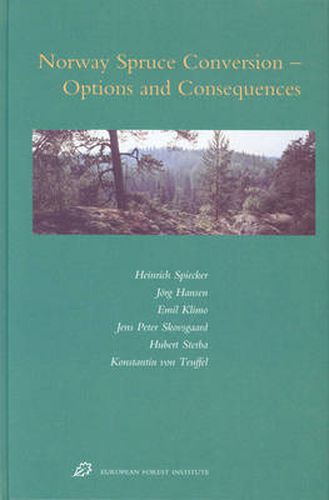Readings Newsletter
Become a Readings Member to make your shopping experience even easier.
Sign in or sign up for free!
You’re not far away from qualifying for FREE standard shipping within Australia
You’ve qualified for FREE standard shipping within Australia
The cart is loading…






Up to the end of the 19th century, many European forests suffered from devastation and soil deterioration, which caused fears of timber shortage. In order to counteract this possible shortage, many forest areas were reforested with coniferous tree species, especially Norway spruce (Picea abies [L.] Karst). Consequently, coniferous forests (often Norway spruce forests), consisting of trees of the same age, were established on many sites naturally dominated by broadleaves. As a result, damages caused by storm, snow, ice, drought, insects, fungi and possibly soil degradation seemed to occur more frequently in these secondary Norway spruce forests than in forests consisting of species better adapted to the ambient conditions. Conversion of Norway spruce stands may reduce these risks and upgrade biodiversity and the genetic potential of forests. As the economic results of forestry, future wood markets and various other goods and services that are provided to society by forest ecosystems, are affected by present and future decision-making, all aspects of conversion must be well understood. EFI’s Regional Project Centre, CONFOREST, is continuously striving to improve implementation of conversion projects by consolidation of the expertise available in all forestry disciplines. This book comprises the findings in all conversion-related areas aiming to consider ecosystem needs while ensuring availability of silvicultural methods and operational feasibility of their implementation. Simultaneously, the cost-effectiveness of conversion scenarios is analysed by forestry economists. Since a change in public perception and ecological awareness may cause policy makers to either or not endorse further conversion efforts, input by experts in forestry politics is also provided.
$9.00 standard shipping within Australia
FREE standard shipping within Australia for orders over $100.00
Express & International shipping calculated at checkout
Up to the end of the 19th century, many European forests suffered from devastation and soil deterioration, which caused fears of timber shortage. In order to counteract this possible shortage, many forest areas were reforested with coniferous tree species, especially Norway spruce (Picea abies [L.] Karst). Consequently, coniferous forests (often Norway spruce forests), consisting of trees of the same age, were established on many sites naturally dominated by broadleaves. As a result, damages caused by storm, snow, ice, drought, insects, fungi and possibly soil degradation seemed to occur more frequently in these secondary Norway spruce forests than in forests consisting of species better adapted to the ambient conditions. Conversion of Norway spruce stands may reduce these risks and upgrade biodiversity and the genetic potential of forests. As the economic results of forestry, future wood markets and various other goods and services that are provided to society by forest ecosystems, are affected by present and future decision-making, all aspects of conversion must be well understood. EFI’s Regional Project Centre, CONFOREST, is continuously striving to improve implementation of conversion projects by consolidation of the expertise available in all forestry disciplines. This book comprises the findings in all conversion-related areas aiming to consider ecosystem needs while ensuring availability of silvicultural methods and operational feasibility of their implementation. Simultaneously, the cost-effectiveness of conversion scenarios is analysed by forestry economists. Since a change in public perception and ecological awareness may cause policy makers to either or not endorse further conversion efforts, input by experts in forestry politics is also provided.